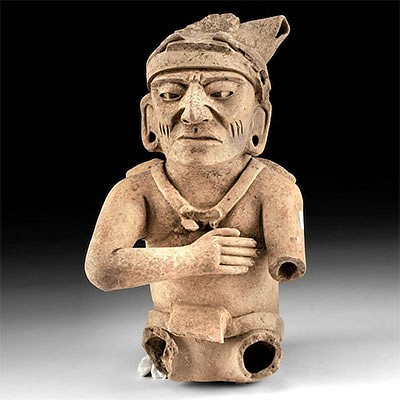Framed Audubon Lithograph, Rocky Mountain Goat ca. 1850
Lot 225
About Seller
Artemis Fine Arts
686 S Taylor Ave, Ste 106
Louisville, CO 80027
United States
Selling antiquities, ancient and ethnographic art online since 1993, Artemis Gallery specializes in Classical Antiquities (Egyptian, Greek, Roman, Near Eastern), Asian, Pre-Columbian, African / Tribal / Oceanographic art. Our extensive inventory includes pottery, stone, metal, wood, glass and textil...Read more
Categories
Estimate:
$900 - $1,350
Absentee vs Live bid
Two ways to bid:
- Leave a max absentee bid and the platform will bid on your behalf up to your maximum bid during the live auction.
- Bid live during the auction and your bids will be submitted real-time to the auctioneer.
Bid Increments
| Price | Bid Increment |
|---|---|
| $0 | $25 |
| $300 | $50 |
| $1,000 | $100 |
| $2,000 | $250 |
| $5,000 | $500 |
| $10,000 | $1,000 |
| $20,000 | $2,500 |
| $50,000 | $5,000 |
| $100,000 | $10,000 |
| $200,000 | $20,000 |
About Auction
By Artemis Fine Arts
Feb 3, 2022
Set Reminder
2022-02-03 10:00:00
2022-02-03 10:00:00
America/New_York
Bidsquare
Bidsquare : VARIETY SALE | Ancient, Asian, Ethnographic
https://www.bidsquare.com/auctions/artemis-gallery/variety-sale-ancient-asian-ethnographic-8833
Join us for our first sale of February with a spotlight on two fabulous collections, one from Lumberton, Texas, and the other from Whisnant Gallery in New Orleans. Artemis Fine Arts info@artemisfinearts.com
Join us for our first sale of February with a spotlight on two fabulous collections, one from Lumberton, Texas, and the other from Whisnant Gallery in New Orleans. Artemis Fine Arts info@artemisfinearts.com
- Lot Description
John James Audubon( American, 1785-1851). Printed and colored by John T. Bowen (American, 1801-ca. 1856). "Rocky Mountain Goat" lithograph in colors - Published in Philadelphia from 1849-1856. A framed octavo sized lithograph of Audubon's "Rocky Mountain Goat", number 26 / plate 128 of "The Vivaparous Quadrupeds of North America" which was created in collaboration with reverend and naturalist John Bachman (1790-1874) who wrote the accompanying text. Audubon and his son John Woodhouse left during the summer of 1843 for an expedition along the Missouri River to depict and document the 4-legged mammals of North America. The esteemed printmaker John T. Bowen produced the set of 150 black and white lithographs which were hand colored. This piece depicts a male and a female goat. One is standing and one is lying upon the foothills, as the Rocky Mountains grace the background. Size of sight view: 6.25" L x 9.25" W (15.9 cm x 23.5 cm) Size of frame: 20.375" L x 23.25" W (51.8 cm x 59.1 cm)
John James Audubon was an American painter, ornithologist, and naturalist who created illustrated zoologies that served as both scientific documents and wonderful works of art on paper in the 19th century before photomechanical processes were the primary method of creating book illustrations. Zoological illustration is a specialized genre of art, and while Audubon sought to accurately depict animals like other illustrators, his work stands apart as an exemplar because he was also concerned with aesthetic considerations and created the finest compositions, meeting the demands of both art and science.
Audubon is perhaps most famous for his depictions of birds; however, he also depicted mammals as we see in this example. Prior to Audubon's work and that of only a few others including John Gould and Josef Wolf, most ornithological and zoological illustrations were not drawn from life but rather from mounted specimens, showing a bird perching upon a branch for example. Audubon was one of the first to impart motion and instill life in his illustrations. What's more the medium of colored lithography was ideal for capturing the vivid hues of birds' plumage and mammals' fur.
Provenance: private Colorado, USA collection; Private Collection of a Private Colorado Family
All items legal to buy/sell under U.S. Statute covering cultural patrimony Code 2600, CHAPTER 14, and are guaranteed to be as described or your money back.
A Certificate of Authenticity will accompany all winning bids.
b>PLEASE NOTE: Due to recent increases of shipments being seized by Australian & German customs (even for items with pre-UNESCO provenance), we will no longer ship b>PLEASE NOTE: Due to recent increases of shipments being seized by Australian & German customs (even for items with pre-UNESCO provenance), we will no longer ship firm.
Display stands not described as included/custom in the item description are for photography purposes only and will not be included with the item upon shipping.
#168455This hand-colored lithograph has not been examined outside the frame but appears to be in excellent condition. Set in museum quality framing by Mary Williams Fine Arts of Boulder, Colorado. Wired for suspension and ready to display.Condition
- Shipping Info
-
All shipping is handled in-house for your convenience. Your invoice from Artemis Gallery will include shipping calculation instructions. If in doubt, please inquire BEFORE bidding for estimated shipping costs for individual items.
-
- Buyer's Premium



 EUR
EUR CAD
CAD AUD
AUD GBP
GBP MXN
MXN HKD
HKD CNY
CNY MYR
MYR SEK
SEK SGD
SGD CHF
CHF THB
THB













